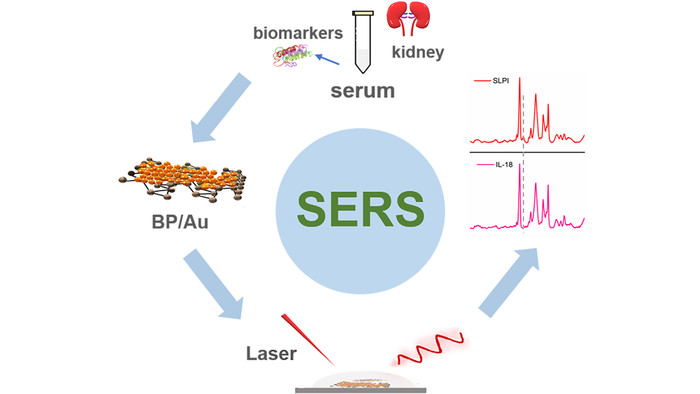WASHINGTON — A new way to evaluate the quality of kidneys before transplantation could one day help increase the number of usable donor kidneys. The method uses highly sensitive spectroscopy analysis to detect biomarkers related to kidney injury, which could also be useful for diagnosing kidney problems in patients.

Credit: Hui Chen, University of Shanghai for Science and Technology, and Mingxing Sui, Shanghai Changhai Hospital of Shanghai
WASHINGTON — A new way to evaluate the quality of kidneys before transplantation could one day help increase the number of usable donor kidneys. The method uses highly sensitive spectroscopy analysis to detect biomarkers related to kidney injury, which could also be useful for diagnosing kidney problems in patients.
“Today, the lack of methods for precisely measuring donor kidney injury and predicting transplant outcome leads to high discard rates and recipient complications in clinical practice,” said research team leader Mingxing Sui from Changhai Hospital of Shanghai in China. “We want to solve this problem by developing a new system that can noninvasively provide an objective measure of donor kidney quality.”
In the Optica Publishing Group journal Optics Express, Sui and colleagues from the University of Shanghai for Science and Technology in China report the first use of surface-enhanced Raman scattering (SERS) for simultaneous, ultrasensitive detection of two important kidney injury biomarkers. They also describe how they made SERS spectroscopy more practical for clinical use.
“This highly sensitive SERS-based multiplexing technique can rapidly capture subtle changes in the biomarker expression levels associated with donor kidney injury,” Sui said. “This paves the way for objectively assessing the quality of donor kidneys in clinical practice.”
Finding a better way
When a person donates a kidney after death, the process often involves taking a biopsy to assess the health of the kidney that will be donated. This step is not only invasive and time consuming but might also be causing too many donor kidneys to be disqualified. Research has shown that biopsy findings don’t always predict how well a kidney will function once transplanted.
Recently, researchers have identified secretory leukocyte peptidase inhibitor (SLPI) and interleukin 18 (IL-18) as biomarkers present in a person’s blood and urine that can be used to objectively evaluate kidney injury. Although various analysis methods have been explored to detect these biomarkers, they have all come up short due to limited sensitivity, lack of multiplexing, complicated sample preparation or high cost.
Sui’s research team wanted to find out if SERS could provide a better way to detect these biomarkers. This relatively new vibrational spectroscopy technique offers single-molecule sensitivity, is easy and fast to perform, and allows multiple biomarkers to be detected using a single measurement. It works by using nanostructures to enhance the Raman scattering that occurs when molecules are adsorbed onto a metal surface. This scattering forms a type of spectral fingerprint that is unique for each molecule.
However, moving SERS out of the lab and into the clinic required finding ways to further improve its sensitivity, reproducibility and simplicity. The researchers achieved this by developing a new hybrid SERS substrate that combined gold nanoparticles with a new 2D nanomaterial known as black phosphorus. The new nanosheets offer several advantages, including a high affinity toward the biomolecules, which boosts the sensitivity. They also eliminate the need for labels, making measurements easier to perform.
Testing the sensitivity
Tests of the new hybrid SERS substrate showed a reproducible detection limit down to 1.53×10-8 milligrams per milliliter for SLPI and 0.23×10-8 milligrams per milliliter for IL-18. The researchers also demonstrated that up to 97% of the biomarker molecules in blood serum samples could be recovered using their SERS method. These results indicate the high sensitivity and reliability of the method.
“Although this work is still at an early stage, we think SERS could be used in clinical practice in the foreseeable future,” Sui said. “By collecting the donor urine or serum, the expression level of kidney injury biomarkers could be noninvasively, rapidly and reproducibly measured, which is highly preferable in clinical practice in contrast to biopsies of kidneys.”
The researchers are now working to identify more biomarkers that could help to more accurately assess donor kidney quality. They are also developing machine learning algorithms to improve the interpretation of the spectral fingerprints.
Paper: H. Chen, C. Luo, L. Xing, H. Guo, P. Ma, X. Zhang, L. Zeng, M. Sui, “Simultaneous and ultra-sensitive SERS detection of SLPI and IL-18 for the assessment of donor kidney quality using black phosphorus/gold nanohybrids,” Opt. Express, Vol. 30, Issue 2, pp. 1452-1465 (2022)
DOI: https://doi.org/10.1364/OE.445809
About Optics Express
Optics Express reports on scientific and technology innovations in all aspects of optics and photonics. The bi-weekly journal provides rapid publication of original, peer-reviewed papers. It is published by The Optical Society (OSA) and led by Editor-in-Chief James Leger of the University of Minnesota, USA. Optics Express is an open-access journal and is available at no cost to readers online at OSA Publishing.
About Optica Publishing Group (formerly OSA)
Optica Publishing Group is a division of Optica, the society advancing optics and photonics worldwide. It publishes the largest collection of peer-reviewed content in optics and photonics, including 18 prestigious journals, the society’s flagship member magazine, and papers from more than 835 conferences, including 6,500+ associated videos. With over 400,000 journal articles, conference papers and videos to search, discover and access, Optica Publishing Group represents the full range of research in the field from around the globe.
Journal
Optics Express
DOI
10.1364
Method of Research
Experimental study
Article Title
Simultaneous and ultra-sensitive SERS detection of SLPI and IL-18 for the assessment of donor kidney quality using black phosphorus/gold nanohybrids
Article Publication Date
5-Jan-2022




